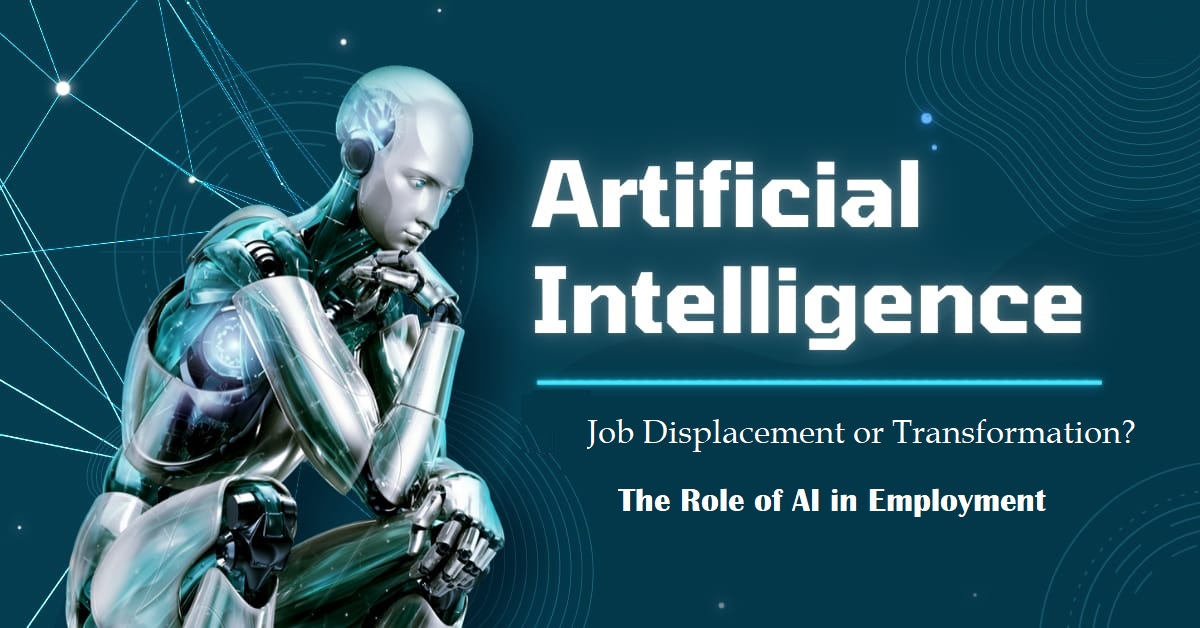Job Displacement or Transformation? The Role of AI in Employment
The rapid advancement of artificial intelligence (AI) has sparked widespread debate and concern about its impact on employment. Many fear that AI will lead to widespread job displacement, rendering human workers obsolete. However, a more nuanced understanding reveals that while certain job roles may indeed be displaced, AI also has the potential to transform industries, create new job opportunities, and enhance human productivity. This blog explores the complex relationship between AI and employment, examining both the displacement and transformative aspects.
- The Fear of Job Displacement:
- Automation of Routine Tasks: One of the primary concerns is that AI-driven automation will replace human workers in jobs that involve repetitive and routine tasks. This includes jobs in manufacturing, data entry, customer service, and transportation. The fear is that AI-powered systems can perform these tasks more efficiently and accurately, potentially leading to significant job losses.
- Technological Unemployment: The concept of technological unemployment raises concerns that AI will render a significant portion of the workforce jobless. The fear is that AI’s ability to perform complex cognitive tasks, coupled with advancements in robotics, could eliminate the need for human workers in various industries, leading to a surge in unemployment rates.
- Fear of Irrelevance: Employees worry that their skills may become obsolete in an AI-dominated job market. This fear stems from the belief that AI systems can outperform humans in areas such as data analysis, pattern recognition, and decision-making, leaving workers feeling threatened and uncertain about their future employability.
- Historical precedents:
Here are a few historical instances where technological advancements initially led to job displacement but were followed by the creation of new job opportunities:
- Industrial Revolution: The Industrial Revolution, beginning in the 18th century, brought about significant technological advancements, particularly in manufacturing and agriculture. The introduction of machinery and automation led to job displacement for many artisans and agricultural workers. However, it also created new jobs in factories, such as machine operators, mechanics, and engineers, as well as in supporting industries like transportation and logistics.
- Agricultural Mechanization: The mechanization of agriculture in the 19th and 20th centuries resulted in job displacement for a large number of farm laborers. As machinery and automation replaced manual labor, fewer workers were needed for tasks like plowing, planting, and harvesting. However, this shift led to the emergence of new roles in agricultural engineering, machinery maintenance, and agricultural research, as well as opportunities in related industries such as food processing and distribution.
Digital Revolution: The rise of computers and the digital revolution in the late 20th century caused disruptions across various industries. Jobs that involved manual data processing, typewriting, and record-keeping were automated, resulting in job displacement. However, this transformation also gave rise to new job opportunities in computer programming, software development, IT support, data analysis, and digital marketing.
- Transformation of the Printing Industry: The advent of desktop publishing and digital printing technologies revolutionized the printing industry in the late 20th century. Traditional printing methods, such as typesetting and letterpress, were largely replaced by digital printing processes. This led to job displacement for many typesetters and press operators. However, the digital transformation created new roles in graphic design, digital prepress, web development, and online publishing.
- Rise of E-commerce: The widespread adoption of e-commerce platforms and online retail disrupted the traditional brick-and-mortar retail industry. As more consumers shifted to online shopping, there was a decline in jobs related to traditional retail sales and cashier roles. However, this shift also created new employment opportunities in e-commerce logistics, digital marketing, web design, customer service, and last-mile delivery services.
These historical instances demonstrate that while technological advancements initially displaced certain jobs, they also led to the emergence of new industries, professions, and opportunities. It highlights the importance of adaptability and reskilling to navigate changing job markets and take advantage of the new roles that arise from technological advancements.
- The Transformative Potential of AI:
Here are some industries that have leveraged AI to create new job roles, open up untapped markets, and drive economic growth:
- Information Technology (IT) and Software Development: AI has transformed the IT industry by creating new job roles and expanding market opportunities, including:
- AI engineers and developers: These professionals specialize in developing AI algorithms, machine learning models, and AI-driven software solutions.
- Data scientists and analysts: With the increasing availability of data, there is a growing demand for professionals who can extract insights, develop predictive models, and drive data-driven decision-making.
- Healthcare and Medical Technology: AI is revolutionizing the healthcare industry, leading to the creation of new job roles and improved patient care:
- AI in medical research: Researchers utilize AI algorithms to analyze complex datasets, identify patterns, and accelerate drug discovery and development processes.
- Health informatics specialists: These professionals leverage AI to manage and analyze health data, ensuring data privacy and security while extracting valuable insights for healthcare providers.
- Telemedicine and remote healthcare: AI-powered platforms enable remote consultations, diagnostics, and monitoring, creating opportunities for healthcare professionals in virtual care settings.
- E-commerce and Retail: AI technologies have disrupted the e-commerce and retail sectors, opening up new markets and driving economic growth:
- Personalized marketing and recommendations: AI algorithms analyze customer data to deliver personalized marketing campaigns and product recommendations, leading to increased sales and customer satisfaction.
- Supply chain optimization: AI-driven systems optimize inventory management, demand forecasting, and logistics, creating new job roles in supply chain analytics and operations management.
- Voice assistants and chatbots: AI-powered virtual assistants enhance customer support and engagement, leading to improved customer experiences and increased sales conversions.
- Financial Services: AI has transformed the financial industry, creating new job roles and driving innovation:
- Quantitative analysts and algorithmic traders: These professionals leverage AI algorithms to analyze financial data, develop trading strategies, and execute high-frequency trades.
- Fraud detection and risk management: AI-powered systems identify fraudulent activities, assess risk, and enhance compliance, leading to new opportunities in fraud analysis and risk assessment.
- Autonomous Vehicles and Transportation: The development of autonomous vehicles and AI-driven transportation systems has created new job roles and transformed the transportation industry:
- Autonomous vehicle engineers: These professionals specialize in developing AI algorithms, sensor technologies, and control systems for self-driving vehicles.
- Fleet management and logistics optimization: AI-powered systems optimize route planning, delivery schedules, and vehicle maintenance, creating opportunities in logistics optimization and operations management.
These industries represent a fraction of the many sectors that have harnessed the power of AI to create new job roles, tap into untapped markets, and drive economic growth. As AI technology continues to advance, its integration into various industries will likely create further opportunities for innovation and job creation.
- Collaborative AI and Human Workforce:
AI technology has been successfully integrated to enhance human productivity and job performance, resulting in job transformation rather than displacement:
- Healthcare: AI has been applied in various areas of healthcare to improve diagnostics, treatment, and patient care. For example:
- Medical imaging analysis: AI algorithms can assist radiologists in analyzing medical images, helping to detect abnormalities and improve diagnostic accuracy.
- Clinical decision support systems: AI-powered systems can provide healthcare professionals with real-time insights, assisting in treatment planning and medication recommendations.
- Virtual nursing assistants: AI-driven virtual assistants can provide personalized care instructions, reminders, and health monitoring to patients, supporting healthcare providers and enhancing patient outcomes.
- Customer Service and Support: AI technologies have been integrated into customer service roles to enhance efficiency and customer experience:
- Chatbots and virtual assistants: AI-powered chatbots can handle routine customer inquiries, freeing up human agents to focus on complex or specialized cases.
- Natural language processing: AI-driven systems can analyze customer interactions to understand sentiment and provide personalized recommendations, improving the quality of customer support.
- Financial Services: AI is being utilized in the financial industry to improve decision-making, risk assessment, and fraud detection:
- Algorithmic trading: AI algorithms can analyze market data and make high-speed trading decisions, assisting financial professionals in executing trades.
- Fraud detection: AI-based systems can analyze vast amounts of financial data to identify patterns and anomalies, helping financial institutions detect and prevent fraudulent activities.
- Personalized financial advice: AI-powered robo-advisors can provide tailored investment recommendations based on individual goals and risk profiles, expanding access to financial planning services.
- Manufacturing and Automation: AI technologies have transformed the manufacturing sector by improving efficiency, quality control, and automation:
- Collaborative robots (cobots): AI-driven robots can work alongside human workers, assisting with repetitive or physically demanding tasks, resulting in increased productivity and reduced physical strain on human workers.
- Predictive maintenance: AI algorithms can analyze sensor data and predict equipment failures, enabling proactive maintenance and minimizing downtime.
- Education: AI has the potential to transform education by personalizing learning experiences and assisting educators:
- Intelligent tutoring systems: AI-powered systems can adapt learning materials and provide personalized feedback to students, helping them learn at their own pace and addressing individual needs.
- Automated grading and feedback: AI algorithms can assess and provide feedback on assignments and exams, saving time for educators and allowing for more timely feedback to students.
These examples demonstrate how AI technology can augment human capabilities, improve efficiency, and provide valuable support in various industries, ultimately leading to job transformation rather than complete displacement. By embracing AI as a tool to enhance human productivity and performance, new opportunities for collaboration and specialized roles can emerge.
- Future Prospects and Strategies:
- Jobs of the future: Emerging job roles and industries that are likely to emerge or be significantly transformed as a result of AI advancements, such as data science, machine learning engineering, and AI ethics consulting.
- Lifelong learning and adaptability: Need for continuous learning and adaptability in the face of evolving job markets, and strategies for individuals and organizations to stay ahead of the curve.
- Social and economic implications: AI technology brings both opportunities and challenges. It can lead to job displacement and economic inequality, raising concerns about ethics and privacy. Adapting to changing workforce dynamics and acquiring new skills are crucial, while responsible AI deployment and accountability are essential for mitigating potential risks and ensuring societal benefits.
Conclusion:
AI undoubtedly brings both challenges and opportunities to the employment landscape. While job displacement is a valid concern, it is crucial to recognize the transformative potential of AI and its capacity to create new job roles and enhance human productivity. By understanding the collaborative nature of AI and adopting proactive strategies, individuals and organizations can navigate the evolving job market, harnessing the power of AI while preserving the value of human labor.


